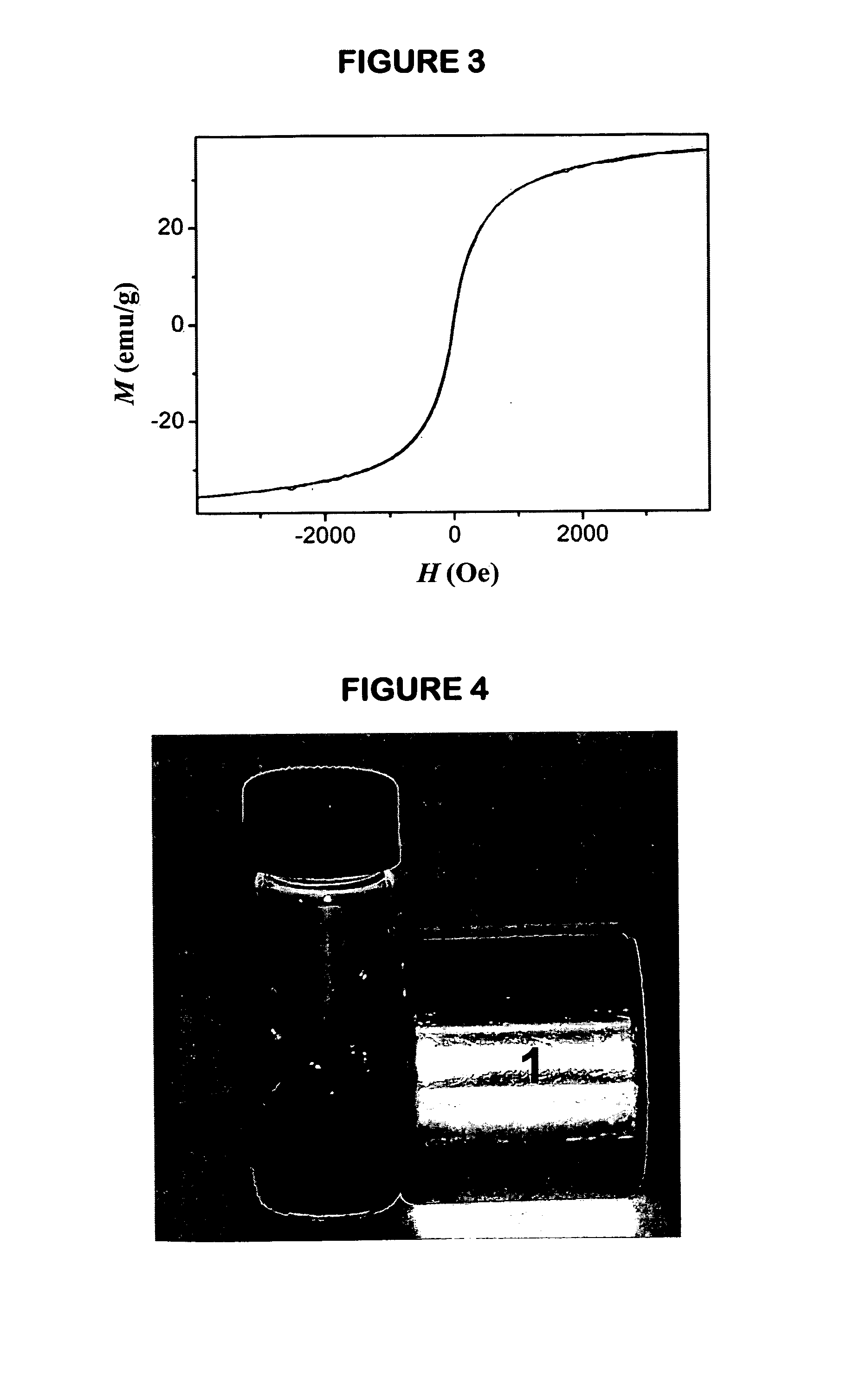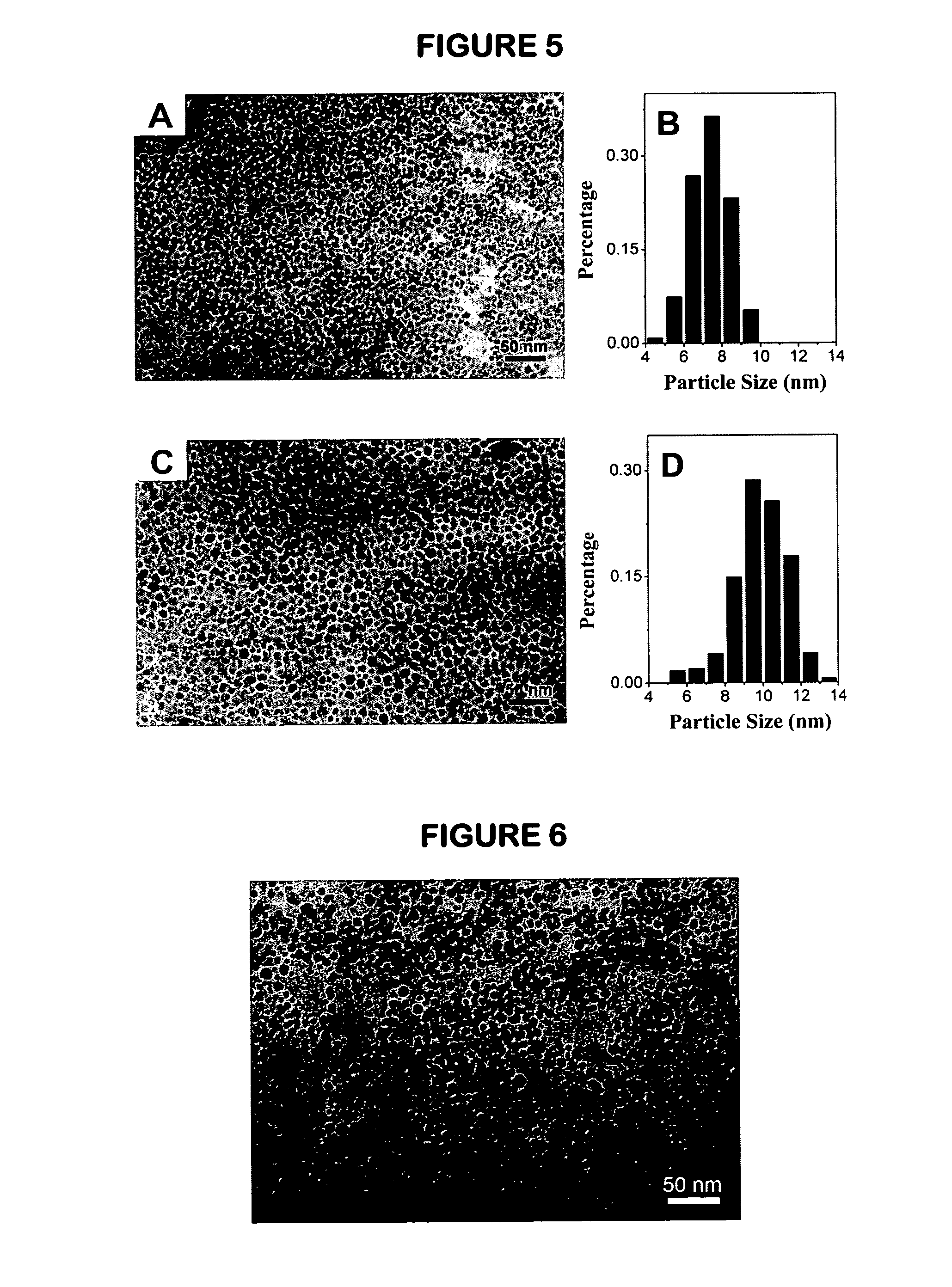Biocompatible magnetic nanocrystal, powder of a biocompatible magnetic nanocrystal bearing a surface reactive group and preparations thereof
a biocompatible magnetic nanocrystal and biocompatible technology, applied in the direction of magnetic bodies, magnetic paints, transportation and packaging, etc., can solve the problems of poor ability of sonochemical methods to control the size and morphology of the resultant nanoparticles, difficult post-preparation procedures, and inability to directly use them at single particle level for in vivo applications. , to achieve the effect of high crystallinity, high soluble content and high crystallinity
- Summary
- Abstract
- Description
- Claims
- Application Information
AI Technical Summary
Benefits of technology
Problems solved by technology
Method used
Image
Examples
example 1
[0103]1.06 g Fe(acac)3, 12 g α,ω-dicarboxyl-terminated PEG2000 (prepared according to reference, see: Adv. Mater., (2005) 17(8), 1001) and 3.87 mL oleylamine were dissolved in 50 mL phenyl ether, then the solution was transferred to a 100 mL three-necked flask. After being purged with nitrogen for 30 minutes, the solution was refluxed for 20 hours. The reaction was terminated by cooling the reaction system to room temperature. The resultant magnetic nanocrystals bearing surface carboxyl group were precipitated and washed three times by ether. The biocompatible magnetic nanocrystals were collected by centrifugation. Subsequently, the Fe3O4 nanocrystals were redissolved in deionized water. After dialysis against pure water for 24 hours, the Fe3O4 nanocrystals were precipitated again and then washed by a mixture of ether and acetone (V:V=3:1). Via vacuum drying, a black powder of the biocompatible magnetic nanocrystals which can be stored and transported conveniently was obtained. The ...
example 2
[0104]The dissolvability of the biocompatible magnetic nanocrystals in powder form obtained by Example 1 was tested after the nanocrystals being kept at room temperature for half a year by completely dissolving 0.6 g powder sample in 100 mL 0.01 M PBS (pH=7.4) buffer. FIG. 4 shows a photograph of the resultant buffer solution of the powder sample. The photograph was captured by placing the magnetic fluid near a permanent magnet. No precipitates were presented in the resultant magnetic fluid after it was stored for half year.
example 3
[0105]4.24 g Fe(acac)3, 48 g α,ω-dicarboxyl-terminated PEG2000 and 15.5 mL oleylamine were dissolved in 200 mL phenyl ether, then the solution was transferred to a 250 mL three-necked flask. After being purged with nitrogen for 50 min, 140 mL reaction solution was extracted and then transferred into a pressure equalizing funnel mounted on the three-necked flask. The reaction solution remained in the flask was then refluxed for 2 hours. After that, 140 mL stock solution in the pressure equalizing funnel was introduced dropwise into the flask under reflux conditions. After the whole dripping process lasted for 2 hours was completed, the refluxing process was kept going for another 20 hours for growing larger nanocrystals in comparison with those shown in Example 1. The following processing procedures for purification, isolation and vacuum drying were the same as those described in Example 1. FIG. 5 presents TEM images and the particle size distributions of the magnetic Fe3O4 nanocryst...
PUM
| Property | Measurement | Unit |
|---|---|---|
| particle size | aaaaa | aaaaa |
| temperature | aaaaa | aaaaa |
| time | aaaaa | aaaaa |
Abstract
Description
Claims
Application Information
 Login to View More
Login to View More - R&D
- Intellectual Property
- Life Sciences
- Materials
- Tech Scout
- Unparalleled Data Quality
- Higher Quality Content
- 60% Fewer Hallucinations
Browse by: Latest US Patents, China's latest patents, Technical Efficacy Thesaurus, Application Domain, Technology Topic, Popular Technical Reports.
© 2025 PatSnap. All rights reserved.Legal|Privacy policy|Modern Slavery Act Transparency Statement|Sitemap|About US| Contact US: help@patsnap.com



